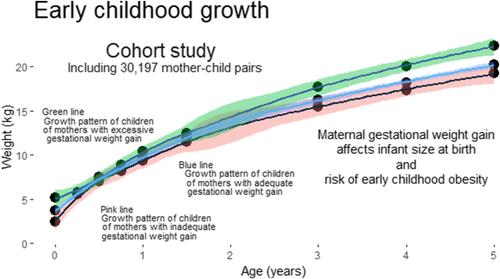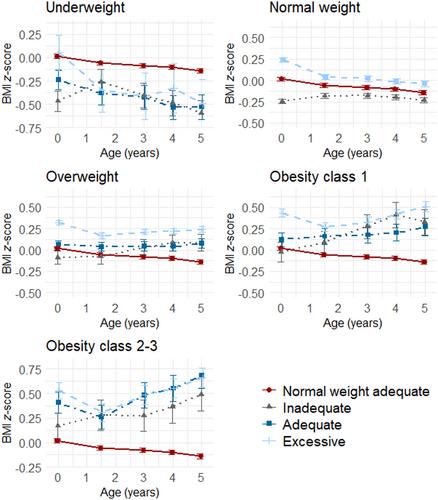Childhood obesity is associated with maternal obesity, but the link to gestational weight gain (GWG) is not fully elucidated. We examined the relationship between early pregnancy maternal body mass index (BMI) and GWG on early childhood growth.
Data from 30 197 mother–child pairs from Uppsala County Mother and Child Cohort were divided into 15 groups according to maternal BMI and GWG, based on World Health Organization classification and Institute of Medicine guidelines, respectively. Postnatal growth patterns were analyzed with linear mixed regression models within maternal BMI groups. Odds ratios of overweight and obesity at 4 years of age were assessed with logistic regression analyses. We treated children of mothers with normal weight and adequate GWG as the reference group, and all analyses were adjusted for potential confounders.
GWG was associated with infant BMI z-score at birth, independent of potential confounding factors. Independent of GWG, we observed an overall decrease in BMI z-score from 18 months to 5 years in children of mothers who were underweight, while an increase in BMI z-score was seen in children of mothers who were overweight or obese. In children of normal- and overweight mothers, the risk of childhood overweight and obesity was associated with excessive compared to adequate GWG (adjusted odds ratio [aOR] 1.17, 95% confidence interval [CI] 1.01–1.36 for normal-weight mothers, and aOR 1.25, 95% CI 1.04–1.51 for overweight mothers, respectively). Children of mothers with obesity and excessive GWG had the highest risk of being overweight or obese at 4 years (aOR 2.88, 95% CI 2.40–3.44, and 4.38, 95% CI 3.37–5.67, respectively). Associations did not differ between children of mothers with obesity class 1 and 2–3 when comparing excessive and adequate GWG (aOR 1.33, 95% CI 0.96–1.85, and 1.12, 95% CI 0.74–1.70, respectively).
Maternal GWG affects infant birth size and growth until 18 months, although maternal BMI is more crucial for childhood growth beyond 18 months. Further, children of mothers who are normal- or overweight and experience excessive GWG have an increased risk of obesity at 4 years.



